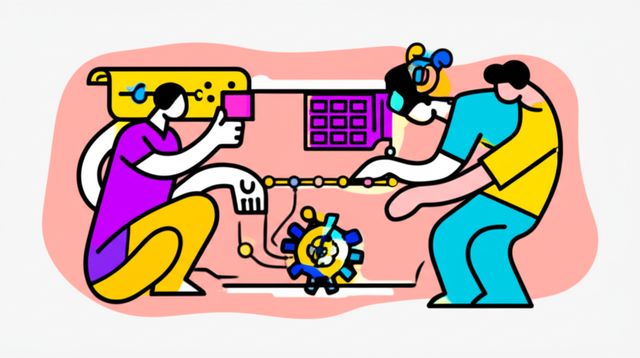Object-Relational Mapping
May 1, 2024
2 minute read

Object-Relational Mapping (ORM) is a powerful technique used in software engineering that simplifies the interaction between object-oriented programming languages and relational database management systems. It enables developers to work with data in a more object-oriented way, making it easier to map real-world entities and their relationships to database tables and columns.
Why Learn Object-Relational Mapping?
There are several compelling reasons why individuals may choose to learn Object-Relational Mapping. These include:
-
Improved Productivity: ORMs reduce the boilerplate code required for data access, allowing developers to focus on business logic.
-
Reduced Development Time: By automating repetitive tasks, ORMs streamline the development process, saving time and effort.
-
Enhanced Maintainability: ORMs provide a consistent interface for data access, making code easier to understand and maintain.
-
Increased Flexibility: ORMs support multiple database systems, allowing developers to switch between them without significant code changes.
-
Better Code Reusability: ORMs enable the sharing of data access logic across different applications, improving code reusability.
How Online Courses Can Help You Learn Object-Relational Mapping
Online courses offer a convenient and flexible way to learn Object-Relational Mapping. These courses typically cover the following key concepts:
- Fundamentals of ORMs
- Mapping Objects to Database Tables
- Querying and Updating Data Using ORMs
- ORM Performance Optimization
- Advanced ORM Techniques
Through a combination of video lectures, hands-on projects, and interactive exercises, online courses provide learners with the opportunity to gain a comprehensive understanding of ORMs. By engaging with these courses, learners can develop the skills and knowledge necessary to effectively use ORMs in their own software development projects.
Careers Related to Object-Relational Mapping
Object-Relational Mapping is a valuable skill for professionals working in various roles within the software industry, including:
-
Software Engineers: Use ORMs to develop and maintain software applications.
-
Database Administrators: Use ORMs to manage and optimize database systems.
-
Web Developers: Use ORMs to create dynamic and data-driven web applications.
-
Data Analysts: Use ORMs to extract and analyze data for business intelligence.
-
Data Scientists: Use ORMs to prepare and process data for machine learning models.
Conclusion
Object-Relational Mapping is a powerful technique that simplifies data access and manipulation in software development. By learning ORMs, individuals can unlock new possibilities for building data-intensive applications, improving their productivity, and enhancing their career prospects.
Find a path to becoming a Object-Relational Mapping. Learn more at:
OpenCourser.com/topic/hgm3f9/object
Reading list
We've selected ten books
that we think will supplement your
learning. Use these to
develop background knowledge, enrich your coursework, and gain a
deeper understanding of the topics covered in
Object-Relational Mapping.
Introduces the principles and practices of domain-driven design, which software design approach that focuses on the domain of the problem being solved. It covers topics such as domain modeling, bounded contexts, and aggregate roots. The book is suitable for software architects and developers who want to improve their skills in domain-driven design.
This classic book by Martin Fowler introduces architectural patterns for enterprise applications. It covers topics such as domain-driven design, layering, and object-relational mapping. The book valuable resource for architects and developers who want to design and implement scalable and maintainable enterprise applications.
Introduces the principles and practices of designing data-intensive applications. It covers topics such as data modeling, consistency, and scalability. The book is suitable for software architects and developers who want to build scalable, reliable data-intensive applications.
Introduces the principles and practices of building microservices, which are small, independent services that can be deployed and scaled independently. It covers topics such as service design, communication, and deployment. The book is suitable for software architects and developers who want to learn about microservices.
Introduces the principles and practices of refactoring, which is the process of improving the design of existing code. It covers topics such as object-oriented design patterns, code smells, and refactoring techniques. The book is suitable for software developers who want to improve their skills in refactoring.
Provides a comprehensive introduction to Java, a popular programming language that includes an ORM. It covers topics such as object-oriented programming, data structures, and algorithms. The book is suitable for both beginners and experienced Java developers.
Introduces the fundamental principles of object-oriented programming, which are essential for understanding ORM. It covers topics such as encapsulation, inheritance, and polymorphism. The book is written in a clear and concise style, making it suitable for beginners in object-oriented programming.
Provides a comprehensive introduction to MySQL, a popular open-source database management system. It covers topics such as data modeling, SQL queries, and performance optimization. The book is suitable for both beginners and experienced MySQL users.
While not specifically about object-relational mapping, this book provides a thorough introduction to JavaScript, which widely used language for web development and can be used for ORM. It covers topics such as data structures, algorithms, and object-oriented programming, which are essential for understanding ORM concepts.
Introduces the fundamental principles of object-oriented programming in C++. It covers topics such as classes, objects, inheritance, and polymorphism. The book is suitable for beginners in object-oriented programming.
For more information about how these books relate to this course, visit:
OpenCourser.com/topic/hgm3f9/object


